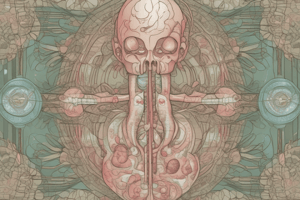Podcast
Questions and Answers
What type of communication occurs when a hormone acts on adjacent cells?
What type of communication occurs when a hormone acts on adjacent cells?
- Paracrine (correct)
- Autocrine
- Endocrine
- Neurocrine
Which of the following regulatory functions is NOT controlled by the endocrine system?
Which of the following regulatory functions is NOT controlled by the endocrine system?
- Metabolism
- Blood glucose
- Muscle contraction (correct)
- Immune system
What is the function of the hypothalamic-hypophyseal portal?
What is the function of the hypothalamic-hypophyseal portal?
- To control the rate of secretion of hormones (correct)
- To produce hormones
- To regulate body temperature
- To store hormones
What is the effect of excessive growth hormone before adolescence?
What is the effect of excessive growth hormone before adolescence?
Which hormone is responsible for stimulating the release of cortisol?
Which hormone is responsible for stimulating the release of cortisol?
What is the primary function of oxytocin in the female reproductive system?
What is the primary function of oxytocin in the female reproductive system?
What is the source of iodine necessary for thyroid hormone formation?
What is the source of iodine necessary for thyroid hormone formation?
What is the effect of excessive thyroid hormones on children?
What is the effect of excessive thyroid hormones on children?
What is the primary function of parathyroid hormone?
What is the primary function of parathyroid hormone?
What is the treatment for hypothyroidism in children?
What is the treatment for hypothyroidism in children?
Flashcards are hidden until you start studying
Study Notes
Endocrine System
- Communicates through autocrine, paracrine, and endocrine methods
- Regulatory functions include metabolism, food intake and digestion, tissue development, ion levels, water balance, cardiovascular, blood glucose, reproductive function, uterine contraction, milk release, and immune system
Hormones
- Hyper means excess, hypo means deficient
- Hypothalamus controls pituitary gland through releasing and inhibitory hormones
- Hormones pass through the hypothalamic-hypophyseal portal to control secretion rates
Pituitary Gland (Hypophysis)
- Also known as the master gland of hormones
- Pea-sized gland located in sella turcica, connected to the hypothalamus via the pituitary stalk
- Surgery: hypophysectomy, can be done transsphenoidal
- Two parts: anterior (adenohypophysis) and posterior (neurohypophysis)
Anterior Pituitary Hormones
- Growth hormone (somatropin) promotes body protein synthesis, decreases fat stores, conserves carbs, and affects tissue sensitivity to insulin
- Excessive growth hormone can lead to gigantism (before adolescence) or acromegaly (after adolescence)
- Adrenocorticotropic hormone (corticotropin) stimulates cortisol release, increasing blood sugar, decreasing immune response, and increasing bone resorption
- Thyroid-stimulating hormone (thyrotropin) stimulates T3 and T4 release
- Follicle-stimulating hormone and luteinizing hormone stimulate estrogen and progesterone release, respectively
- Prolactin promotes mammary gland development and milk production
Posterior Pituitary Hormones
- Oxytocin stimulates uterine contractions and milk letdown reflex
- Antidiuretic hormone (vasopressin) conserves fluid and is a potent vasoconstrictor
Thyroid Gland
- Located below the larynx, on each side of the trachea
- Secretes thyroxine (T4), triiodothyronine (T3), and calcitonin
- Composed of follicles filled with colloid containing thyroglobulin
- Iodine is necessary for thyroid hormone formation, obtained from iodized salt
- T3 and T4 are stored for 2-4 months, deficiency is not immediately observed, and systemic effects are slow onset and long duration
- Affects growth, mainly in children, can lead to cretinism (hypothyroidism) or excessive skeletal growth (hyperthyroidism)
Studying That Suits You
Use AI to generate personalized quizzes and flashcards to suit your learning preferences.




